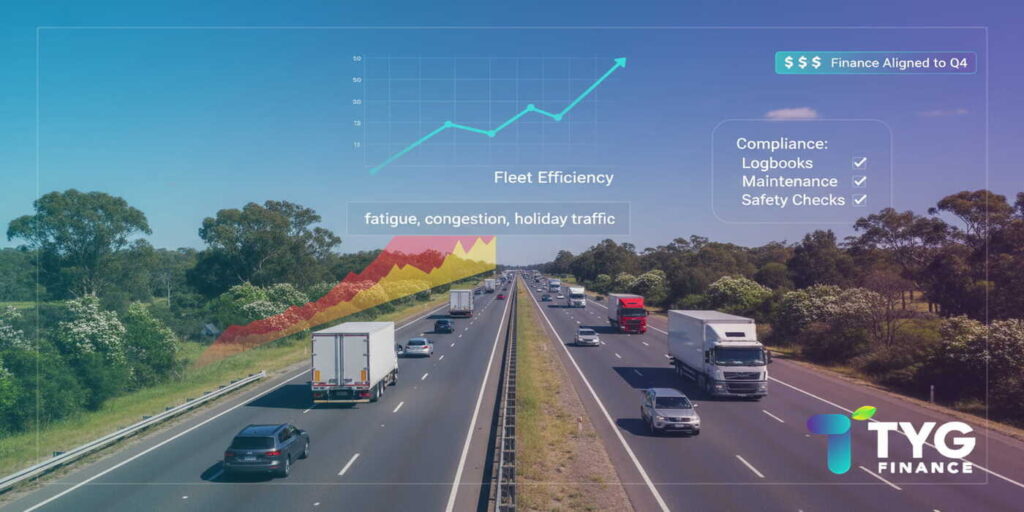More Than Just a Season Change
Spring brings more vehicles onto Australian roads: harvest logistics, construction deliveries, regional tourism, and school traffic. For fleet operators, this means higher exposure to road risk just as workloads increase. Managing safety and efficiency together isn’t optional; it’s the difference between smooth operations and expensive disruptions.
This article outlines practical ways to lift road safety and fleet efficiency at the same time — and how financing can help operators act before Q4 pressure hits.
Step 1: Treat Safety as an ROI Driver
Safety investments reduce incidents, cut insurance claims, and protect contracts.
Where operators focus
- Driver readiness: fatigue management, route planning around peak holiday corridors, toolbox refreshers.
- Vehicle condition: tyres, brakes, lighting, ADR-compliant load restraint.
- In-cab tech: telematics, dash cams, and ADAS features (lane departure, AEB) to support better decisions.
The Australian Road Safety Foundation provides campaigns and guidance relevant to commercial operators.
Step 2: Lift Efficiency Through Fleet Review
- Fuel consumption: Older vehicles often cost more per kilometre; data can highlight candidates for replacement.
- Breakdown rates: A small set of assets typically drives most downtime; replacing them unlocks capacity.
- Asset mix: The wrong truck for the job (over-specced or under-specced) erodes margins quietly.
Use Fleet Finance to stage upgrades that improve both efficiency and safety.
Step 3: Keep Pace With Compliance
The NHVR continues to evolve fatigue, mass/dimension, and vehicle standards. Spring is a smart month to:
- Audit logbooks and EWD settings.
- Confirm defect rectifications and maintenance logs are current.
- Replace vehicles that can’t economically meet safety or emissions expectations.
Staying audit-ready preserves reputation and avoids costly interruptions during Q4.
Step 4: Finance as the Bridge Between Intention and Action
Financing enables operators to act on safety and efficiency without draining reserves.
How finance supports safer, leaner fleets
- Modern safety tech now: Step into vehicles with ADAS and improved cabins to support driver wellbeing.
- Consolidated facilities: Replace scattered loans with a single structure aligned to cash flow.
- Pre-approval capacity: Move quickly when a suitable unit becomes available or a tender requires proof of capability.
Truck Finance can pair with fleet facilities to modernise high-impact units first.
Building a Safety Culture Drivers Actually Believe In
- Peer-led mentoring: Pair new drivers with respected veterans; reward safe decisions publicly.
- Near-miss reporting without blame: Rapid lessons learned beat quiet cover-ups that repeat.
- Data that helps, not harasses: Use telematics to coach trends, not micromanage individuals.
Spec’ing for Spring and Summer Conditions
- Cooling packages: High-capacity radiators and fan clutches for long pulls in heat.
- Brake packages: Disc conversions or upgraded drums on hilly regional runs.
- Visibility & lighting: LED light bars compliant with ADR, clean lenses, and correct aim for dawn/dusk haulage.
Cost-Saving Levers Often Overlooked
- Idle-reduction policies: Telematics-based coaching cuts fuel bills without slowing delivery.
- Spec matching: Right-sizing axles and gearing to duty cycles prevents silent profit leaks.
- Parts standardisation: Fewer SKUs mean faster turnarounds and better buying power.
Road Risk Map for Spring (Thought-Starter)
- Tourist corridors: Sudden braking and erratic lane changes — plan overtaking zones and rest stops.
- Regional harvest routes: More slow-moving plant and loaded trailers — leave margin, brief escorts where needed.
- Urban delivery peaks: School zones and construction detours — tight time windows demand pre-planned routes.
Finance FAQ for Safer, Leaner Fleets
Can I finance safety retrofits, not just new trucks?
Often yes — depending on the scope and asset profile. Some operators finance ADAS kits, EWD upgrades, and braking improvements.
What if my fleet is varied and messy?
Consolidated facilities can bring clarity. Many carriers standardise gradually — replace the worst units first, then align the rest as contracts allow.
How do I show ROI on safety?
Track incident rates, insurance claims, fuel burn, and unplanned downtime before and after upgrades. Clients notice the difference — and so do insurers.
Spring Logistics Calendar (Sample)
| Week | Focus | Actions |
|---|---|---|
| Week 1 | Compliance reset | Logbook audit, defect closeouts, schedule NHVR inspections |
| Week 2 | People & training | Toolbox refreshers, route briefings, near-miss review |
| Week 3 | Fleet upgrades | Commission replacements, ADAS installs, telematics tuning |
| Week 4 | Tender readiness | Pre-approval updates, capability statements, route risk maps |
Example: A Metro–Regional Transport Operator
A mid-sized carrier replaced two ageing prime movers with newer models featuring AEB and lane-departure warnings. Fuel spend fell, unplanned workshop time dropped, and drivers reported lower fatigue on long pulls. Financing spread the cost and aligned repayments to major client payment cycles, protecting working capital for peak season.
Conclusion: Spring Into Safer, Smarter Operations
Safety and efficiency aren’t competing goals — they compound. Operators who invest in both reduce risk, save money, and strengthen relationships with drivers and clients alike. Spring is the right time to act so Q4 doesn’t become a scramble.
Get Pre-Approved Today with TYG Finance and build a fleet that’s both safe and efficient.


